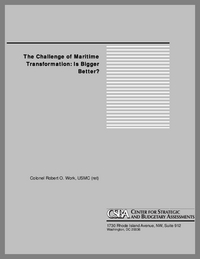
The once mighty U.S. Navy is in precipitous decline. At least, that is what a vocal group of naval officers, defense analysts and Congressional leaders strongly believe. They support their judgment by comparing the number of ships in the Navy’s “Total Ship Battle Force” with those of past U.S. fleets. Their most common standard for comparison is the “600-ship” fleet championed by John Lehman, President Ronald Reagan’s first, most aggressive and politically savvy, Secretary of the Navy. When compared to that number, the 316 ships of the Fiscal Year
2001 Total Ship Battle Force seem at first glance to provide alarming evidence in support of the “large fleet” faction’s dire conclusion.
Totally lost in a narrow focus on fleet ship counts is an appreciation for the fleet’s dramatically improved combat capabilities. Consider a comparison between the surface combatant fleet that existed at the end of the Cold War with that of the 316-ship fleet in service on September 30, 2001. On December 31, 1989, the fleet counted 104 large surface combatants, 15 deployable carriers, and four battleships, for an escort-to-capital ship ratio of 5.5:1. In 2001, there were 80 combatants and 11 carriers, for a 7.27:1 escort-to-capital ship ratio. Moreover, the 24 fewer combatants carried 784 more missiles than their 1989 counterparts. The smaller fleet is thus much more efficient in delivering combat power. Since 1989 the average displacement (in tons) and average number of Sailors per missile carried in fleet missile magazines have fallen by 19 percent and 38 percent, respectively.
More tellingly, of the 123 capital ships and large surface combatants in the 1989 fleet, only 48 (39 percent) were capable of delivering either long-range air or missile strikes against targets ashore. In operational terms, this meant the strike power of the 1989 fleet was heavily concentrated in its carrier force. Of the 108 non-carrier platforms, only 33 battleships and surface combatants could contribute to long-range fleet strike power, for a non-carrier strike platform-to-carrier ratio of 2.2:1.
Compare these figures with the 2001 fleet. Of its 91 capital ships and large surface combatants, 86 (95 percent) are strike capable, and the non-carrier strike platform to carrier ratio is over three times higher, at 6.8:1. Vice Admiral Dennis McGinn, the current Deputy Chief of Naval Operations for Navy Warfare Requirements and Programs, has rightly concluded that “The 600- ship Navy of the 1980s cannot compare with the combat capability of the preset fleet.”
The debate between those who judge the fleet primarily by the number of its ships and those who focus on its capabilities is an important one. Its outcome will determine, in no small way, how future naval appropriations will be prioritized, as well as the way that the fleet will configure itself for 21st century operations. This paper makes the case that while numbers do count, it is overall fleet capabilities that ultimately matter. And in this regard, the evidence clearly suggests that as a result of a broad, ongoing naval technical revolution, the capabilities found in today’s 316-ship fleet make it the most powerful ever put to sea.
Indeed, the following review of the fleet’s expanding capabilities suggests that leaders inside and outside the Department of the Navy should worry less about chasing higher fleet numbers that are unrealistic, unaffordable and undesirable, and more about how they might spark real a real transformation in maritime power-projection operations. This spark could come as the Navy and Fleet Marine Forces, working closely together, begin to better exploit the potential of their new and emerging capabilities and to effect corresponding changes in their operational concepts, operational patterns and organizational structures. By so doing, tomorrow’s fleet would be better prepared for mid-term challenges, and funds might be freed up to increase the pace and scope of fleet experimentation, to both hedge against unexpected future threats and to better illuminate the requirements for the “fleet-after-next.”



























